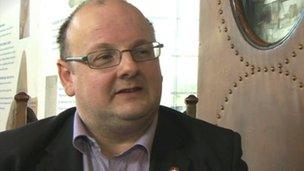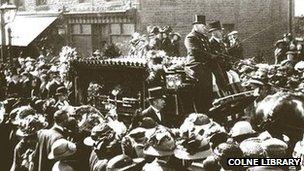Titanic disaster: Riddle of violin link to band leader
- Published

The inventory for Hartley's body records a fountain pen, 16 shillings, a silver matchbox, a gold cigarette case and some letters.
The Lancashire town of Nelson may be named after Britain's legendary naval leader - but down the road in Colne they have their own hero of the high seas.
Colne is the birthplace - and final resting place - of Wallace Hartley, the band leader on the Titanic, the man who played on as the ship went down.
It is a well-known story, one that features in every book or film about the disaster, but a few weeks ago it took on new life with claims the violin Hartley played on deck that night had turned up in an auction house in Wiltshire.

Nigel Hampson is sceptical that Hartley's violin could have survived
Hartley's story is told in the recently opened Titanic in Lancashire Museum, in the town's Old Grammar School. It is based around the personal collection of self-confessed "Titanorak" Nigel Hampson.
He said: "The story of Wallace Hartley still attracts and affects people. What he did that night sums up a vanished era of self-sacrifice, duty and a very British understated courage."
But much as he would love the rediscovered violin story to be true, Mr Hampson is, to say the least, sceptical.
The story emerged earlier this year. Auctioneers Henry Aldridge and Sons in Devizes, Wiltshire, who specialise in Titanic memorabilia, suggested one of Hartley's distant relatives was in possession of the famous violin.
The instrument showed signs of water damage and bore his initials and an inscription from Maria Robinson, his fiancée.
The claim this could be the violin from the Titanic is based around a newspaper story two weeks after the sinking. It reported Hartley's body had been found and that a music case, containing his violin, was strapped to his chest.
Aldridge and Sons have sent the violin for tests and said they would give a statement once the results were known.
Mr Hampson said: "The idea that the violin could have survived two weeks being battered about in the North Atlantic is preposterous."

Wallace Hartley's funeral was attended by over 30,000 people
The sceptics also point to the fact the authorities carried out a detailed inventory of the personal effects found on each body.
The inventory for Wallace Hartley records a fountain pen, 16 shillings, a silver matchbox, a gold cigarette case and some letters.
Not on the ship
"This was a detailed record. I just find it very hard to believe that if a violin had been found on the body nobody saw fit to mention it," Mr Hampson said.
But fellow Titanoraks in Colne say we should wait and see before dismissing the claims.
Darran Ward, a local historian who has written a book on Hartley, said he wanted to know more.
"I've seen a picture of the violin in question and it does look water damaged and there is evidence to suggest it may be his violin," he said.
"They are doing scientific tests at the moment so let's just see what that reveals."
Mr Hampson believes the violin may well have belonged to Hartley but was not on the ship.
"It looks like it did belong to him but musicians always have several instruments and this is probably one he left at home," he said.
Hartley was born at 92 Greenfield Street, the son of a mill worker. He learned music as a pupil at the George St Wesleyan School and later played at the Bethel Independent Methodist Chapel where his father was choirmaster.
He played in small groups and orchestras in the north before signing up for the White Star Line.
He was buried in Colne cemetery with the funeral attended by over 30,000 people.
The monument over his grave includes a violin and the opening notes of Nearer, My God, To Thee - the hymn he reputedly played as the ship sank.
- Published12 March 2012
- Published9 April 2012
- Published7 April 2012
- Published5 April 2012